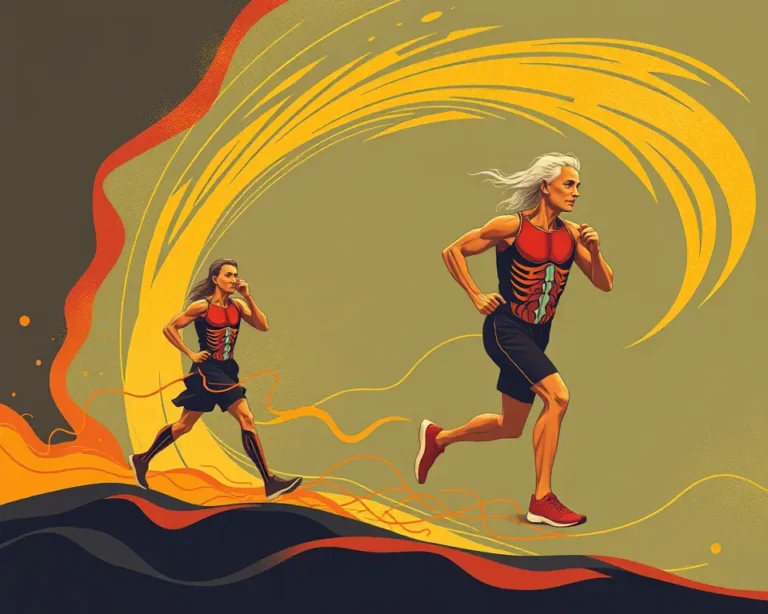Maintaining core strength is crucial as we age, impacting everything from balance and posture to overall mobility and quality of life. Many believe that building a strong core requires intense gym sessions or complicated equipment. However, a simple bodyweight routine can be incredibly effective, even for those in their 70s and beyond. This article reveals a straightforward yet powerful 5-move bodyweight routine that can help anyone, regardless of age, achieve a stronger core. Inspired by Dr. Kaye Cleave’s journey, who at 76, credits a similar routine for her impressive core strength, we’ll explore each exercise in detail, offering modifications and tips to make them accessible and beneficial for all fitness levels.
Why Core Strength Matters As We Age
As we get older, maintaining muscle mass becomes increasingly important. Core strength, in particular, plays a vital role in several aspects of healthy aging:
- Balance and Stability: A strong core helps improve balance and stability, reducing the risk of falls, a major concern for seniors.
- Posture: Core muscles support the spine, contributing to better posture and reducing back pain.
- Mobility: A strong core enhances overall mobility, making everyday activities like walking, bending, and lifting easier and more comfortable.
- Injury Prevention: A well-conditioned core acts as a natural brace, protecting the spine and reducing the risk of injuries during physical activity.
- Functional Fitness: Core strength is essential for functional fitness, which refers to the ability to perform daily tasks with ease and independence.
The 5-Move Bodyweight Core Routine
This routine focuses on simple, effective exercises that can be performed at home without any equipment. It’s designed to be adaptable to different fitness levels, with modifications provided for each exercise.
Important Note: Before starting any new exercise routine, it’s essential to consult with a healthcare professional, especially if you have any underlying health conditions or concerns.
1. Leg Lifts
- How to: Lie on your back with your legs extended and your arms at your sides. Engage your core and slowly lift both legs off the ground, keeping them straight. Raise your legs until they are at a 45-degree angle or as high as you comfortably can. Slowly lower your legs back down, maintaining control throughout the movement.
- Why it Works: Leg lifts target the lower abdominal muscles, helping to improve core stability and strength.
- Modifications:
- Easier: Bend your knees slightly or lift one leg at a time. You can also place your hands under your lower back for added support.
- Harder: Add ankle weights or perform the exercise on a decline bench.
- Sets and Reps: 1-2 sets of 30 seconds
2. Hollow Hold
- How to: Lie on your back with your arms extended overhead and your legs straight. Engage your core and lift your head, shoulders, and legs off the ground simultaneously. Aim to create a slight curve in your lower back while maintaining a stable core. Hold this position, focusing on keeping your lower back pressed against the floor.
- Why it Works: The hollow hold is an isometric exercise that strengthens the entire core, including the abdominal muscles, lower back, and obliques.
- Modifications:
- Easier: Bend your knees or keep your arms at your sides. You can also lift your head and shoulders only, keeping your legs on the ground.
- Harder: Extend your arms and legs further away from your body to increase the challenge.
- Sets and Reps: 1-2 sets of 30 seconds
3. Back Extension
- How to: Lie face down on the floor with your hands behind your head or extended forward. Engage your lower back muscles and lift your chest off the ground, keeping your legs grounded. Slowly lower your chest back down to the starting position.
- Why it Works: Back extensions strengthen the lower back muscles, which are essential for supporting the spine and maintaining good posture.
- Modifications:
- Easier: Reduce the range of motion or keep your hands on the ground for support.
- Harder: Perform the exercise on a back extension bench or hold a light weight plate against your chest.
- Sets and Reps: 1-2 sets of 30 seconds
4. Bird Dog
- How to: Start on your hands and knees, with your hands directly under your shoulders and your knees directly under your hips. Engage your core and extend your right arm forward and your left leg backward simultaneously, keeping your back flat and your hips square to the ground. Hold this position briefly, then slowly return to the starting position. Repeat on the opposite side, extending your left arm and right leg.
- Why it Works: The bird dog exercise improves core stability, balance, and coordination while strengthening the abdominal muscles, lower back, and glutes.
- Modifications:
- Easier: Extend only your arm or your leg, not both at the same time. You can also perform the exercise against a wall for added support.
- Harder: Hold the extended position for a longer duration or add light ankle weights.
- Sets and Reps: 2-3 sets of 6-8 reps per side
5. Glute Bridge
- How to: Lie on your back with your knees bent and your feet flat on the floor, hip-width apart. Place your arms at your sides with your palms facing down. Engage your glutes and lift your hips off the ground, creating a straight line from your knees to your shoulders. Squeeze your glutes at the top of the movement and hold for a few seconds. Slowly lower your hips back down to the starting position.
- Why it Works: Glute bridges strengthen the glutes, hamstrings, and core muscles, improving hip extension and stability.
- Modifications:
- Easier: Perform the exercise with your feet closer to your body or reduce the range of motion.
- Harder: Perform the exercise with one leg raised off the ground (single-leg glute bridge) or place a weight plate on your hips.
- Sets and Reps: 2-3 sets of 8-12 reps
Tips for Success
- Consistency is Key: Aim to perform this routine 2-3 times per week for optimal results.
- Focus on Form: Proper form is crucial for preventing injuries and maximizing the effectiveness of the exercises. If you’re unsure about the correct form, consider consulting with a fitness professional.
- Listen to Your Body: Pay attention to your body and stop if you experience any pain. It’s okay to modify the exercises or take breaks as needed.
- Progression: As you get stronger, gradually increase the duration, repetitions, or sets of each exercise. You can also try the harder modifications to challenge yourself further.
- Warm-up and Cool-down: Always start with a brief warm-up, such as light cardio and dynamic stretching, and end with a cool-down, such as static stretching, to improve flexibility and reduce muscle soreness.
- Breathe Properly: Focus on breathing deeply and consistently throughout each exercise. Inhale during the eccentric (lowering) phase and exhale during the concentric (lifting) phase.
- Stay Hydrated: Drink plenty of water before, during, and after your workout to stay hydrated.
Beyond the Routine: Lifestyle Tips for Core Strength
In addition to this 5-move routine, several lifestyle habits can contribute to a stronger core:
- Maintain a Healthy Weight: Excess weight, especially around the abdomen, can put a strain on your core muscles.
- Practice Good Posture: Consciously maintain good posture throughout the day, whether you’re sitting, standing, or walking.
- Engage Your Core During Daily Activities: Consciously engage your core muscles when performing everyday tasks like lifting groceries or carrying objects.
- Stay Active: Incorporate regular physical activity into your routine, such as walking, swimming, or dancing, to improve overall fitness and core strength.
- Nutrition: Fuel your body with a balanced diet rich in protein, fruits, vegetables, and whole grains to support muscle growth and repair.
The Takeaway
You don’t need a gym membership or fancy equipment to build a strong core, even in your 70s. This simple 5-move bodyweight routine, inspired by Dr. Kaye Cleave’s success, offers a safe, effective, and accessible way to improve core strength, balance, and overall well-being. By incorporating this routine into your lifestyle and following the tips outlined in this article, you can enjoy a stronger, healthier, and more active life for years to come. Remember to consult your healthcare provider before starting any new exercise program.







